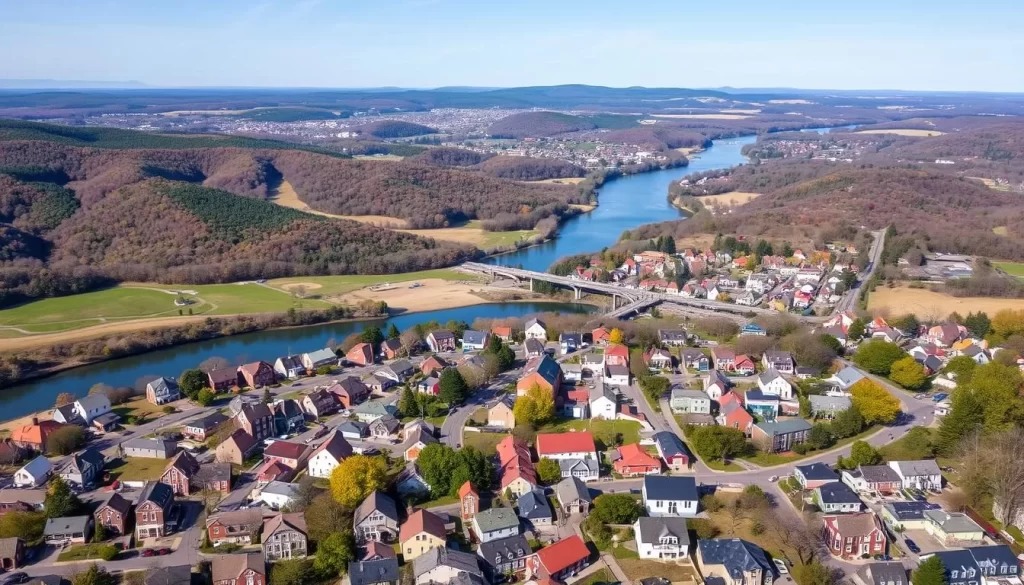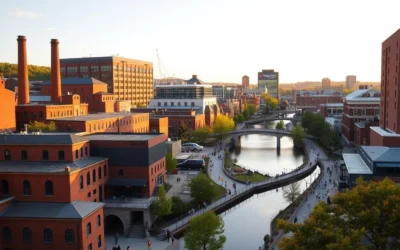✓ Accommodations✓ Flights✓ Rental Cars
You’re about to explore the fascinating linguistic landscape of New Hampshire. While often perceived as homogeneous, this state hosts a diverse array of languages beyond English.
Approximately 8% of New Hampshire’s population, roughly 103,500 people, speak a language other than English at home. Spanish is the most commonly spoken language other than English, representing almost 3% of the total state population.
Understanding the linguistic diversity of New Hampshire provides valuable insights into the state’s cultural diversity and demographic evolution. This introduction sets the stage for exploring the official language status, historical influences on language development, and current demographics.
The Linguistic Landscape of New Hampshire
As you explore New Hampshire, you’ll discover a complex linguistic landscape shaped by its residents. The state’s language profile is influenced by its official language, as well as the diverse languages spoken by its population.
English as the Official Language
English maintains its position as the official language of New Hampshire, used in government operations, legal proceedings, and public education systems. This ensures that all official communications and services are accessible to the majority of the population who speak English. However, the state also recognizes the importance of accommodating speakers of other languages in public services and communications.
For instance, with approximately 8.1% of residents age five and older speaking a language other than English at home, there’s a growing need for language support services. This includes translation and interpretation services to ensure equal access to essential services for all residents.
Language Diversity Overview
The linguistic diversity in New Hampshire has been steadily increasing, presenting both opportunities and challenges. About 2.36% of the population is considered to have Limited English Proficiency (LEP), affecting their ability to access healthcare, government services, and educational opportunities.
- The state’s language diversity is an important aspect of its cultural fabric.
- Understanding this diversity is crucial for developing inclusive policies and services.
- Languages spoken in New Hampshire include a variety of languages, reflecting the state’s growing multicultural community.

Historical Immigration Patterns and Language Evolution
Understanding New Hampshire’s language evolution requires examining its historical immigration patterns. The state’s linguistic landscape has been shaped by various waves of immigration, starting from the early European settlers to more recent arrivals.
Colonial and Early European Settlement
The original inhabitants of the region were Native American tribes, each with their own distinct language. The arrival of English and Scotch-Irish settlers in the early 18th century, beginning in 1719, marked the beginning of English as the dominant language in the southwestern and south-central parts of New Hampshire. European immigration between 1845 and 1920 further diversified the linguistic landscape.

French Canadian Influence
Following the Civil War, French Canadians immigrated to New Hampshire, primarily from Quebec, and settled in industrial cities. By the end of World War I, New Hampshire had the highest percentage of French Canadians of any state, creating vibrant French-speaking communities that significantly influenced the state’s cultural and linguistic development.
Modern Immigration Trends
Unlike many other states, New Hampshire historically saw limited immigration from Hispanic, Asian, and Pacific Island nations. However, modern immigration trends have gradually increased language diversity, albeit at a slower pace than in many other parts of the United States. Today, you can still find evidence of historical immigration patterns in the linguistic communities throughout New Hampshire.
New Hampshire, United States: Official and Widely Spoken Languages
Understanding the languages spoken in New Hampshire is crucial for various industries, including healthcare, education, and government services. As you explore the linguistic landscape of this state, you’ll find that while English is the predominant language, there’s a significant minority speaking other languages at home.
Current Language Demographics
With approximately 539,116 households in New Hampshire, about 8.1% of people aged five and older speak a language other than English at home, totaling around 106,550 residents. This demographic reflects both historical immigration patterns and recent population changes. The majority of non-English speakers also speak English “very well,” with proficiency rates ranging from 60% to 76% across different language groups.
| Language Spoken at Home | Number of Speakers | Percentage of Total Population |
|---|---|---|
| English | 1,233,450 | 91.9% |
| Language other than English | 106,550 | 8.1% |
Limited English Proficiency Statistics
Limited English Proficiency (LEP) affects about 2.36% of New Hampshire’s population, creating challenges for accessing essential services. This highlights the need for language assistance in healthcare, legal, and government settings to ensure inclusivity and equity.
Regional Language Distribution
Regional language distribution varies significantly across New Hampshire, with greater linguistic diversity typically found in urban areas and industrial centers. Understanding these demographics is crucial for businesses, healthcare providers, government agencies, and educational institutions to effectively serve all communities within the state.

As you navigate the complexities of language demographics in New Hampshire, it’s clear that the state’s relatively small size makes tracking language demographics more manageable. However, it also means that language minority communities may be more isolated and face greater challenges in accessing services. Thus, tailored translation services and multilingual support are essential for fostering inclusivity.
Top 10 Non-English Languages in New Hampshire
As you explore the linguistic landscape of New Hampshire, you’ll discover a range of languages being spoken by the state’s residents. The diversity of languages reflects the state’s history, cultural influences, and immigration patterns.
Spanish
Spanish is the most widely spoken non-English language in New Hampshire, with around 30,856 speakers, making up about 2.39% of the population. This significant presence is a result of the growing Hispanic community in the state.
French (Including Cajun)
French, including Cajun, holds a strong second position with around 17,619 speakers, representing 1.36% of the population. This reflects the historical French Canadian immigration to the region.
Chinese (Including Cantonese and Mandarin)
Chinese languages, including Cantonese and Mandarin, rank third with approximately 5,793 speakers, or 0.45% of the population. These languages are primarily concentrated in urban and academic centers.
Portuguese
There are about 4,937 Portuguese speakers in New Hampshire, making up 0.38% of the population. They form small but vibrant communities throughout the state.
Nepali, Marathi, and Other Indic Languages
Nepali, Marathi, and other Indic languages are spoken by around 4,187 residents, or 0.32% of the population, representing more recent immigration patterns.
German
German maintains a presence with about 3,600 speakers, or 0.28% of the population, reflecting both historical European immigration and more recent arrivals.
Arabic
Arabic speakers number around 3,051, or 0.24% of the population, with communities growing in urban centers.
Greek
Approximately 2,695 residents speak Greek, or 0.21% of the population, maintaining cultural and linguistic traditions in specific communities.
Vietnamese
Nearly 0.17% of the population, or about 2,192 residents, speaks Vietnamese, primarily in urban areas.
Swahili and Other African Languages
Swahili and other African languages round out the top 10 with approximately 2,167 speakers, or 0.17% of the population, representing growing African immigrant communities.
These language communities often develop specialized services, cultural centers, and businesses that cater to their specific linguistic needs. As a result, translation and localization services for these top languages are increasingly important for healthcare providers, government agencies, and businesses seeking to serve New Hampshire’s diverse population.

Conclusion: The Importance of Linguistic Diversity in New Hampshire
The Granite State’s diverse linguistic profile is more than just a demographic statistic; it’s a reflection of the community’s strength and resilience. Linguistic diversity in New Hampshire plays a crucial role in shaping the state’s cultural identity and social fabric. Understanding and embracing this diversity is essential for developing inclusive policies and services that meet the needs of all residents.
As New Hampshire continues to evolve demographically, the importance of language access services, professional interpreters, and culturally responsive approaches will only increase. By valuing the knowledge and insight that comes from diverse linguistic backgrounds, New Hampshire can build stronger communities and a more resilient state economy. Regular updates to language demographic data will ensure that language services remain relevant and effective.
The above is subject to change.
Check back often to TRAVEL.COM for the latest travel tips and deals.






